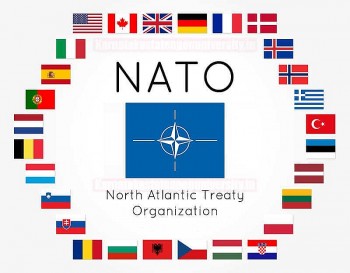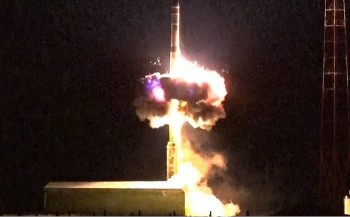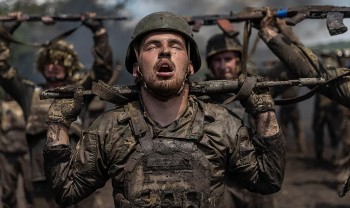Where Are NATO Military Bases Located in Europe?
 How Many Members Are There in NATO Right Now? How Many Members Are There in NATO Right Now? Which nations are currently members of NATO? A complete list of every nation on the most recent NATO Countries List can be found on KnowInsiders.com. ... |
 |
| Mihail Kogalniceanu NATO air-base near Constanta city, Romania |
Warns of Strike on NATO Bases
Dmitry Medvedev, deputy chairman of Russia’s Security Council and a close ally of President Vladimir Putin, has warned about the possibility of striking NATO military bases. His comments, reported by Russian state news agency Tass, came in response to the West's authorization for Ukraine to use long-range weapons.
Medvedev stated that if the conflict escalates further, “it is impossible to rule out anything,” as NATO member states are "effectively fully involved in this conflict." He accused NATO of not only supplying weapons and financial aid to Ukraine but also directly engaging by providing targeting data and controlling missiles used against Russia.
While acknowledging the tragic implications of such a scenario, Medvedev noted it remains “entirely possible” and reiterated that Russia seeks peace, but only one that fully considers its interests.
Previously, Medvedev also warned the U.S. against transferring nuclear weapons to Ukraine, calling it a potential preparation for nuclear conflict. He emphasized that such an act could be interpreted as direct aggression against Russia under its nuclear deterrence policies.
These warnings come amidst heightened tensions after U.S. President Joe Biden authorized Ukraine to use long-range weapons. Ukraine has since deployed U.S.-made ATACMS and Anglo-French Storm Shadow missiles in strikes against Russian territory, further escalating the conflict. Medvedev has characterized the ongoing war as "already World War III."
 World War III in the Predictions of Prophets and Thinkers World War III in the Predictions of Prophets and Thinkers |
How Many NATO Military Bases Are There in Europe?
The exact number of NATO military bases in Europe is not publicly disclosed as a single, comprehensive figure due to the complexity of NATO's operations and the fact that many bases are national facilities that host NATO forces. However, NATO operates or has a presence in hundreds of facilities across Europe, including air bases, naval bases, and command centers.
Key Examples of NATO's Presence:
-
Eastern Europe:
- Enhanced Forward Presence (eFP) battlegroups in Estonia, Latvia, Lithuania, and Poland.
- Aegis Ashore missile defense systems in Romania and Poland.
- Air policing bases in the Baltic states and Eastern Europe.
-
Western and Central Europe:
- Major facilities in Germany, such as Ramstein Air Base (USAFE headquarters).
- Naval and air bases in the UK, Spain, and Italy.
-
Southeastern Europe and the Black Sea Region:
- Mihail Kogălniceanu Air Base in Romania.
- Bezmer Air Base and Graf Ignatievo in Bulgaria.
-
Nordic Region:
- Recent additions with Finland's membership and Sweden’s pending accession.
Estimate:
While NATO doesn’t own most bases outright, it has access agreements and hosts multinational forces in over 200 key locations across Europe. These include dedicated NATO facilities and national bases shared with NATO forces.
Where Are NATO Bases Located in Europe?
The North Atlantic Treaty Organization (NATO) is a collective defense alliance comprising 31 member states, predominantly located in Europe and North America. Established in 1949, NATO’s primary objective is to ensure the security of its members against aggression, with a clear focus on collective defense. NATO's presence in Europe is characterized by numerous military bases strategically positioned across member states. These bases serve as hubs for joint military operations, training, logistics, and intelligence sharing. This article examines the locations and purposes of NATO bases in Europe, considering the latest tensions highlighted by comments from Dmitry Medvedev, Russian Security Council deputy chairman.
NATO's Strategic Deployment in Europe
NATO’s bases in Europe are situated in key regions to deter threats and respond to crises effectively. These locations are strategically chosen to ensure rapid deployment capabilities, safeguard member territories, and strengthen the alliance’s collective defense mechanism. The bases also enhance interoperability among NATO forces by facilitating joint exercises and operational readiness.
Key NATO Objectives for Base Placement:
- Deterrence: Protecting against potential aggressions, particularly from the east.
- Rapid Response: Ensuring the ability to address crises quickly.
- Support for Allies: Reinforcing the security of eastern flank nations bordering Russia.
- Power Projection: Maintaining a robust presence to uphold peace and stability.
Key NATO Bases in Western Europe
Western European NATO countries such as Germany, the United Kingdom, Italy, and Spain host significant NATO infrastructure. These nations are not immediately adjacent to Russia but play a vital role in logistics, air support, and command operations.
Germany:
- Ramstein Air Base: Located in Rhineland-Palatinate, Ramstein is one of NATO's most crucial bases in Europe. It serves as the headquarters of the United States Air Forces in Europe (USAFE) and the NATO Allied Air Command.
- Stuttgart: Home to the U.S. European Command (EUCOM) and NATO's Strategic Command.
United Kingdom:
- RAF Fairford: A forward operating base for NATO and U.S. Air Force heavy bombers.
- Menwith Hill: A significant intelligence and surveillance hub, playing a critical role in NATO’s defense communications.
Italy:
- Naval Air Station Sigonella: Located in Sicily, this base supports NATO operations in the Mediterranean and North Africa.
- Aviano Air Base: A critical NATO facility for rapid deployment in Southern Europe.
Spain:
- Rota Naval Base: A joint U.S.-Spanish naval base that hosts NATO maritime operations.
NATO’s Eastern Flank: Frontline Bases Near Russia
The tension between NATO and Russia has intensified since 2014 following Russia’s annexation of Crimea. Eastern European member states, particularly those bordering Russia, have seen an increase in NATO military presence to reassure allies and deter aggression.
Poland:
- Redzikowo: Hosts an Aegis Ashore ballistic missile defense system under NATO's European Phased Adaptive Approach (EPAA). It is one of the key points of contention for Russia.
- Poznan: Headquarters for NATO’s Enhanced Forward Presence (eFP) in Poland, hosting rotational troops.
Romania:
- Mihail Kogălniceanu Air Base: This base serves as a critical NATO airfield and logistics hub in southeastern Europe, ensuring rapid reinforcement capabilities.
- Deveselu: Another Aegis Ashore site, focusing on missile defense and a focal point of NATO’s strategy in the Black Sea region.
Baltic States (Estonia, Latvia, Lithuania):
- Amari Air Base (Estonia): Hosts NATO's Baltic Air Policing missions.
- Adazi Military Base (Latvia): Headquarters for NATO’s Enhanced Forward Presence in Latvia.
- Rukla (Lithuania): A key base for NATO’s multinational battlegroup in Lithuania.
Turkey:
- Incirlik Air Base: A vital facility for NATO operations in the Middle East and Eastern Europe.
- Izmir Air Station: Hosts the NATO Allied Land Command (LANDCOM).
Central and Southeastern Europe
Countries in Central and Southeastern Europe play a pivotal role in NATO’s operational logistics, given their geographic proximity to both the eastern and southern flanks.
Hungary:
- Papa Air Base: A key strategic airlift hub for NATO, facilitating the movement of troops and supplies.
Bulgaria:
- Bezmer Air Base: Supports NATO’s rapid deployment in the Black Sea region.
- Graf Ignatievo Air Base: Focused on NATO’s air operations.
Slovakia:
- Enhanced NATO presence under the eFP initiative ensures the protection of Slovakian territory and strengthens collective defense efforts.
Nordic Region: Emerging NATO Members
The Nordic region’s role in NATO has been growing, particularly with the accession of Finland and Sweden. These countries bring strategic advantages due to their proximity to Russia and the Arctic.
Finland:
- Though recently joined, Finland’s bases such as Rovaniemi Air Base are expected to integrate into NATO’s Arctic and northern European defense plans.
Norway:
- Bodø Air Base: A critical facility for NATO Arctic operations and surveillance.
NATO’s Current Strategic Challenges
NATO faces significant challenges in Europe, particularly regarding Russia’s increasing threats. Dmitry Medvedev’s comments about potentially striking NATO bases in Poland and Romania underscore the strategic importance of these locations. The concerns are heightened by NATO’s support for Ukraine through arms supplies, training, and intelligence sharing.
Response to Russian Threats:
- NATO has bolstered its presence on the eastern flank, rotating troops and deploying advanced weapon systems.
- Enhanced air policing missions and surveillance activities along borders.
- Conducting large-scale military exercises to demonstrate readiness.
Key Risks:
- Escalation of direct conflict with Russia, especially if NATO assets are targeted.
- Hybrid threats such as cyberattacks on NATO infrastructure.
Conclusion: NATO’s Role in European Security
NATO’s bases in Europe form the backbone of the alliance’s collective defense strategy. They provide the infrastructure needed for deterrence, rapid response, and operational readiness. As tensions with Russia remain high, NATO has reinforced its eastern flank, ensuring the security of member states bordering Russia and the Black Sea region.
While Dmitry Medvedev’s remarks highlight the potential for further escalation, NATO’s robust infrastructure and strategic deployment across Europe ensure that the alliance remains prepared to face emerging threats. The bases in Poland, Romania, and the Baltic States are particularly critical, symbolizing NATO’s commitment to protecting its eastern members and deterring adversarial actions.
FAQs: Where Are NATO Bases Located in Europe?
1. What is the purpose of NATO bases in Europe?
NATO bases in Europe serve multiple purposes, including:
- Deterrence: Protecting member states against external threats.
- Collective Defense: Upholding NATO’s principle of mutual defense (Article 5).
- Rapid Response: Ensuring the alliance can respond swiftly to crises.
- Training and Interoperability: Facilitating joint military exercises and coordination among member states.
2. How many NATO bases are there in Europe?
While there is no exact public figure, NATO operates or has access to over 200 facilities across Europe. These include dedicated NATO facilities and national bases that host NATO forces.
3. Where are the key NATO bases located?
Key bases include:
- Germany: Ramstein Air Base and EUCOM headquarters in Stuttgart.
- Poland: Redzikowo (Aegis Ashore) and Poznan (Enhanced Forward Presence).
- Romania: Deveselu (Aegis Ashore) and Mihail Kogălniceanu Air Base.
- Baltic States: Amari Air Base (Estonia), Adazi Base (Latvia), and Rukla Base (Lithuania).
- Italy: Aviano Air Base and Sigonella Naval Air Station.
- United Kingdom: RAF Fairford and Menwith Hill intelligence hub.
4. Why are NATO bases concentrated in Eastern Europe?
NATO has increased its military presence in Eastern Europe in response to growing tensions with Russia, particularly after the 2014 annexation of Crimea and the ongoing war in Ukraine. These bases act as a deterrent and provide reassurance to member states bordering Russia.
5. Does NATO own these bases?
Most bases are national facilities that host NATO troops under access agreements. NATO also operates dedicated facilities, such as command centers and radar installations.
6. Are there NATO bases in the Nordic region?
Yes. NATO’s presence in the Nordic region is growing, especially after Finland’s accession and Sweden’s pending membership. Key facilities include air bases in Norway and Finland, which play a role in Arctic defense and regional security.
7. How do NATO bases respond to emerging threats?
NATO bases support ongoing operations, intelligence gathering, and military exercises. They are equipped to handle:
- Deploying rapid reaction forces.
- Supporting member states in crises.
- Conducting air policing and missile defense missions.
8. What are the most critical NATO bases for missile defense?
The Aegis Ashore systems in Poland (Redzikowo) and Romania (Deveselu) are vital components of NATO’s ballistic missile defense strategy.
9. How does NATO ensure security for its bases?
NATO employs advanced defense systems, robust surveillance, and multinational troops to secure its bases. Additionally, the alliance conducts regular training and readiness exercises to address potential threats.
10. How do NATO bases contribute to the Ukraine conflict?
While NATO is not directly involved in the war, bases in Eastern Europe serve as hubs for logistics, training, and coordination of military aid to Ukraine. These facilities ensure swift delivery of weapons, humanitarian aid, and intelligence support.
11. Can NATO bases be targeted by adversaries like Russia?
NATO bases are potential targets during heightened conflicts, as indicated by recent threats from Russian officials. However, any attack on NATO facilities would invoke Article 5, triggering a collective response from the alliance.
 The Threat of World War Three from Ukraine’s Use of Long-Range Missiles The Threat of World War Three from Ukraine’s Use of Long-Range Missiles In this analysis, we will explore the geopolitical and military implications of this escalation, examine the rhetoric and potential responses from Russia, and assess whether ... |
 The 10 Most Devastating ICBMs on the Planet: From Sarmat to Minuteman The 10 Most Devastating ICBMs on the Planet: From Sarmat to Minuteman Chinese media outlets have conducted a poll and compiled a ranking of the top 10 intercontinental ballistic missiles (ICBMs) currently regarded as the most powerful ... |
 Who is General Keith Kellogg (Ukraine Envoy) - Early Life, Family, Career, and Nett Worth Who is General Keith Kellogg (Ukraine Envoy) - Early Life, Family, Career, and Nett Worth Donald Trump taps retired General Keith Kellogg for Ukraine envoy role. Check out his biography, personal life, family, career, and net worth. |
 What Is Keith Kellogg’s Plan to End the War in Ukraine? What Is Keith Kellogg’s Plan to End the War in Ukraine? This article delves into the details of Keith Kellogg’s plan, analyzes its feasibility, and forecasts potential outcomes. By examining its key elements and implications, we ... |


























